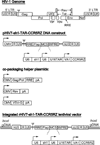Combinatorial RNA-based gene therapy for the treatment of HIV/AIDS
- PMID: 23394377
- PMCID: PMC3732042
- DOI: 10.1517/14712598.2013.761968
Combinatorial RNA-based gene therapy for the treatment of HIV/AIDS
Abstract
Introduction: HIV/AIDS continues to be a worldwide health problem and viral eradication has been an elusive goal. HIV+ patients are currently treated with combination antiretroviral therapy (cART) which is not curative. For many patients, cART is inaccessible, intolerable or unaffordable. Therefore, a new class of therapeutics for HIV is required to overcome these limitations. Cell and gene therapy for HIV has been proposed as a way to provide a functional cure for HIV in the form of a virus/infection resistant immune system.
Areas covered: In this review, the authors describe the standard therapy for HIV/AIDS, its limitations, current areas of investigation and the potential of hematopoietic stem cells modified with anti-HIV RNAs as a means to affect a functional cure for HIV.
Expert opinion: Cell and gene therapy for HIV/AIDS is a promising alternative to antiviral drug therapy and may provide a functional cure. In order to show clinical benefit, multiple mechanisms of inhibition of HIV entry and lifecycle are likely to be required. Among the most promising antiviral strategies is the use of transgenic RNA molecules that provide protection from HIV infection. When these molecules are delivered as gene-modified hematopoietic stem and progenitor cells, long-term repopulation of the patient's immune system with gene-modified progeny has been observed.
Figures

References
-
- Organization, W.H. World Health Organization: Global Epidemic Data and Statistics 2010. 2010 Available from: http://www.who.int/hiv/data/global_data/en/index.html.
-
- CDC. Guidelines for Using Antiretroviral Agents Among HIV-Infected Adults and Adolescents Recommendations of the Panel on Clinical Practices for Treatment of HIV*. Morbidity and Mortality Weekly Report. 2002;51(RR07):1. - PubMed
-
- Rerks-Ngarm S, et al. Vaccination with ALVAC and AIDSVAX to prevent HIV-1 infection in Thailand. N Engl J Med. 2009;361(23):2209–2220. - PubMed
-
-
Hutter G, et al. Long-term control of HIV by CCR5 Delta32/Delta32 stem-cell transplantation. N Engl J Med. 2009;360(7):692–698. * The first study to report the feasilbity of gene therapy where the "Berlin Patient" received an allogeneic bone marrow transplant from a donor with homozygous CCR5Δ32−/Δ32− alleles and demonstrated to be functionally cure of HIV despite not on HAART treatment.
-
Publication types
MeSH terms
Substances
Grants and funding
LinkOut - more resources
Full Text Sources
Other Literature Sources
Medical
